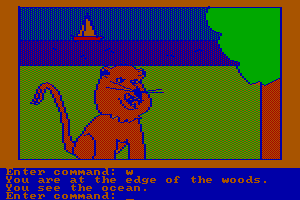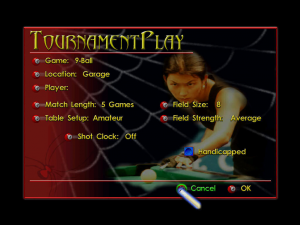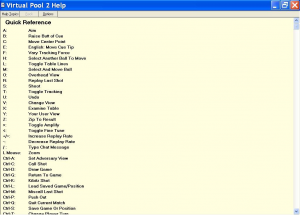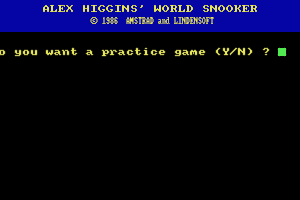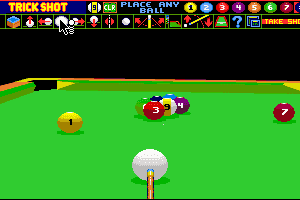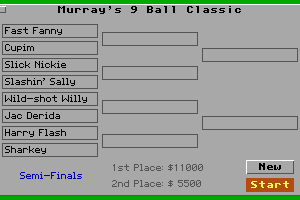Description of Virtual Pool
Overview
Virtual Pool (VP) is the latest, and most certainly the greatest, billiards simulation available on the home PC game market. Offering a variety of billiards games to choose from (8-ball, 9-ball, Straight Pool and Rotation), an accurate physics model, graphics modes to accomodate processors from the 386 to the Pentium, a brief multimedia tutorial and an array of trickshots to sample, VP offers the billiards buff a quality environment in which to enjoy the game.
Interplay takes the interesting stand of claiming that VP will actually improve your own game of billiards, and backs this up with a money-back guarantee. The various features of VP, and its potential as a learning tool, will be examined more closely in the following sections.
Choosing a table - VP's many options
VP offers an interesting recounting of the evolution of the game of billiards throughout the years. This feature is very informative and quite amusing, done in Pythonesque fashion. A multimedia overview of the game's options and rules for each of the 4 games are also available, rendering the printed manual somewhat obsolete. There is also a 5-minute overview of the basics of pool conducted by Lou Butera, a former world champion pool player, who also performs a slew of trick shots that you can marvel at.
Playing pool is what VP is really all about, and once you've gone through the tutorial and seen most of the trick shots that Lou performs, there's nothing left but to step up to the (virtual) table and rack a few balls. You can select to play with a friend, whether in the same room or over a network or modem, play against the computer, or simply just practice.
After making your selections, you are then brought to the end of a table with a set of balls waiting to be broken up by you. This, of course, is the heart of VP.
Everything but the cigarette smoke - The Graphics and Interface
VP uses the mouse and keyboard to simulate the physical act of stroking a cue, and this works pretty successfully for the most part. The mouse is used to aim the cue, adjust the point of contact of the tip to the cueball, and to actually hit the cueball. Various keys can be pressed to raise the butt of the cue, exagerate the force of the stroke (for break shots mainly), and make finer adjustments to tip placement, among other things. An interesting feature is the tracking mode, enabled by pressing 'T' while in practice mode (only). In this mode lines are drawn depicting the path of the ball should the cue ball be hit at that moment. This makes for near-perfect pool playing, which quickly becomes boring. Its main function is to teach you what angles are possible in a given situation.
The stroke is simulated by sliding the mouse back and forth while depressing the 'S' key. Depressing the 'B' key and sliding the mouse will raise/lower the butt of the cue. Holding down the 'E' key and moving the mouse moves the tip of the cue around the cue ball. This system works for the most part quite well, and quickly becomes familiar to you. Pressing 'R' calls up a replay of the last shot you made, which again can be viewed from any angle.
You can also control how you view the table by pressing the 'V' key to move your perspective around (if you need to look at how other balls line up, for example). Zooming in and out and rotating around your current viewpoint are all possible in VP, making any viewing angle achievable. The only letdown to this system is that you cannot adjust your viewpoint when the computer is shooting. It would be nice to have an "over-the-shoulder" look to see just how the computer plans on making its shot. It is also difficult to get a replay of a computer's shot, since immediately after the shot the computer starts "thinking" about its next shot and may not respond to a request for a replay.
One thing that VP demands from you in terms of hardware (other than a pentium, but what title nowadays doesn't? ;) is a VERY clean mouse. Since the stroke of the cue is simulated by sliding the mouse back and forth, harder shots require quicker movement from the mouse. Many times you will find that the mouseball 'slipped' a little when you slide the mouse forward to hit the cueball, thereby not fully stroking through your shot. Other times you can slide your mouse forward a very short distance, but because you did so quickly the cue will smash through the cueball unexpectedly hard. Getting a good, consistent stroke in VP is rather difficult, since its hard to rely upon consistent mouseball behaviour. I would recommend a mouse pad that is not too slick, in order to provide as much grip as possible for the mouseball.
Graphically, VP is very good. The decorative graphics could be better, but I presume would slow down the game some. The pertinent graphics, that of the table surface and the balls, are clear and are detailed enough in 640x480 (more so in 1024x768) mode so as to make sighting long shots possible. The 320x240 mode is not very pleasing, producing very jagged balls. The 1024x768 mode was just a bit too jerky on my system, especially during break shots. All in all, there really isn't much to depicting spheres on a flat surface, and VP does this job well enough.
Other elements of VP could stand some improvement or additions. It would be nice, for example, if you could select optional rules to a particular game to customize it. For example, playing a 'bar-rules' version of 8-ball may be appealing for some people who are used to this game. It would also be nice if an entire game could be recorded, so that memorable games could be played back. A better interface for loading saved positions (which you will do a lot in practice mode) is required, since VP currently has you scrolling through an endless list of trick shot positions that come with the game before getting to the positions that you saved at the bottom. A Windows-style file dialog box is pretty well mandatory here, Interplay. Also, some sort of post-game advice would be useful, where the program could tell you what order you should have shot the balls in, if it differed from your actual order.
These gripes aside, VP's interface functions well, and delivers the graphics required for an enjoyable game of pool.
Are you hustling me? - VP as a learning tool
As mentioned earlier, Interplay stands behind VP with a money-back guarantee if it doesn't improve your 'real-life' game of pool. Will many people be taking Interplay up on this offer? I don't think so. However, VP in no way is going to improve the physical aspect of your pool game. Sliding a mouse back and forth will not improve your stroke, which is what anyone's game ultimately comes down to. VP won't improve your sighting of the ball either, since, despite VP's clear graphics, the experience is not 'virtual' enough to replace the real thing. Weight control will still kill you as much after playing VP as it did before (and if it didn't before, then you didn't have much to learn in the first place ;) since, again, sliding a mouse back and forth doesn't provide any feel for how hard you have to hit the same shot in real-world situations.
So, if VP doesn't improve the above aspects of your game, what does it improve? In my opinion, VP will improve your mental game. VP will teach you how balls react to different forms of english and how the cue ball will move after a particular shot. I use VP to recreate memorable gaffes I made in weekly tournaments. By replaying the shots I botched, I can see how I should have played the shot and what was required to get shape on my next ball. VP will improve your game by showing you what is possible in a given situation. The tracking mode available in VP is great for this.
So, on the whole, I think Interplay's claim is valid. Shots that you missed before getting VP you'll still miss after you've played VP, but VP will have you thinking about the order of your shots better. While the physical aspect of your game (stance, stroke) is vital, no less important is the mental aspect of your game, and it is this side that VP will improve.
Behind the 8-ball - VP's quirks
VP's physical modelling of spherical objects seems to be spot on, but there are two rather notable failings. Unpardonable sin number 1 is that draw is able to be imparted when the cueball is flush along a cushion! The screen shot below shows how ridiculous this looks, with the cue able to pass right through the cushion to strike the cueball below centre. Unpardonable sin number 2 is that, no matter how hard and how low you hit the cueball, it will remain firmly on the table. Now that is some incredible felt! I'm sure the physical modelling is quite accurate, for everything else feels perfect, but you have to wonder what other unseen corners may have been cut if such obvious shortcomings were left in the game. I don't expect to see an accurate depiction of a cueball in flight in VP, but a simple notification of a foul being committed should have been present in cases where the cueball would have jumped the table. 9-ball afficionados will be disappointed, I'm sure, from being prevented from making otherwise legal shots. Similarly, being prevented from lowering the cue tip beyond a certain point in obvious situations should have been implemented. These 2 sins were both present in the pre-release demo. Lets hope Interplay plans to address these problems sometime soon.
The computer opponents are another shortcoming in VP. While the most difficult of computer opponents will leave you gasping for breath, the less-skilled will have you scratching your head. Straight-in shots are often passed over in favour of near-impossible slices. Should you choose the less-skilled computer opponents (such as 'Mrs. Offen'), you'll feel quite comfortable in your game until, at some particular point, they start making the shots that only the most skilled computer opponents make. This "streaky" tendency of computer opponents who otherwise miss very routine shots strains the sense that you are playing against a suitably-skilled opponent. Each computer opponent plays exactly the same, the only difference being how frequently each player goes on one of these hot streaks (the best computer players seem to be permanently on one).
The table size modelled in VP is the standard 41/2'x9' foot pool table. Make that a brand-spanking NEW 41/2'x9' pool table, for the surface seems to be incredibly slick. Balls that I think are on their last gasp seem to roll a few feet farther than anticipated. Being able to select the 'speed' of a table would be useful, as not all tables are as crisp and fast as the one table modelled in VP.
The question of the table brings up other points as well. Why is there only one table modelled in VP? Can't the same physical model be applied to 4'x'8' tables? 6'x12' tables? Why limit the game to just one table dimension? The depth and width of pockets should also be customizable. I read a preview of VP in the Feb. '95 edition of PC Gamer (US ed.), and the writer mentioned that the pre-release version allowed him to play snooker! Now, why would this feature be removed from the final release version? The same principles of physics apply. I posed this question to Interplay, and was told that snooker might be part of some add-on package in the future. What a crock! From the PC Gamer preview, it is apparent that variable table sizes (snooker is played on 6'x12' tables) was part of the development process for some time, so stripping this from the release version can only be construed as an attempt to purposefully limit the scope of the game so that Interplay has something to put on an optional add-on disk. Disappointing, to say the least.
Review By GamesDomain
External links
Captures and Snapshots
Comments and reviews
Amigo 2021-02-13 -1 point
Beautiful classic pool simulator. Works fine on Windows XP (with Win 98/Me compatibility).
Joe Mama 2017-03-18 0 point DOS version
I've got this game but for some reason whenever you play an opponent, they make the absolute worst shots ever. I wonder if this version would be different?
Cengco 2014-04-30 0 point DOS version
This is only a prerelease. You can get the final version without tutorial, pool-history and other information of original CD at DOS-SPIELE.JIMDO.COM
agdbnetru 2013-08-23 0 point DOS version
Virtual Pool - sports simulator, made in full 3D. The player can move around the table, choosing the appropriate position to strike the ball. In addition, the game is equipped with excellent textbook with tips from a professional player. Physics behavior balls at impact deserves only praise.
http://agdb.net.ru/games/virtual_pool.php
Write a comment
Share your gamer memories, help others to run the game or comment anything you'd like. If you have trouble to run Virtual Pool, read the abandonware guide first!
Download Virtual Pool
We may have multiple downloads for few games when different versions are available. Also, we try to upload manuals and extra documentation when possible. If you have additional files to contribute or have the game in another language, please contact us!
DOS Version
Game Extras
Various files to help you run Virtual Pool, apply patches, fixes, maps or miscellaneous utilities.
Mac Version
- Year: 1997
- Publisher: MacPlay
- Developer: Celeris Inc.
Similar games
Fellow retro gamers also downloaded these games:
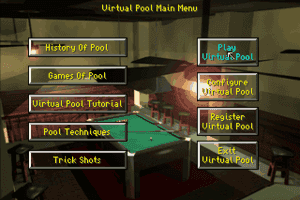
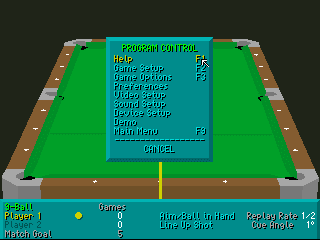
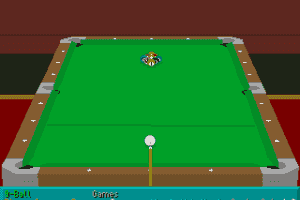
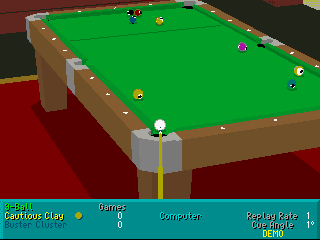

 147 KB
147 KB